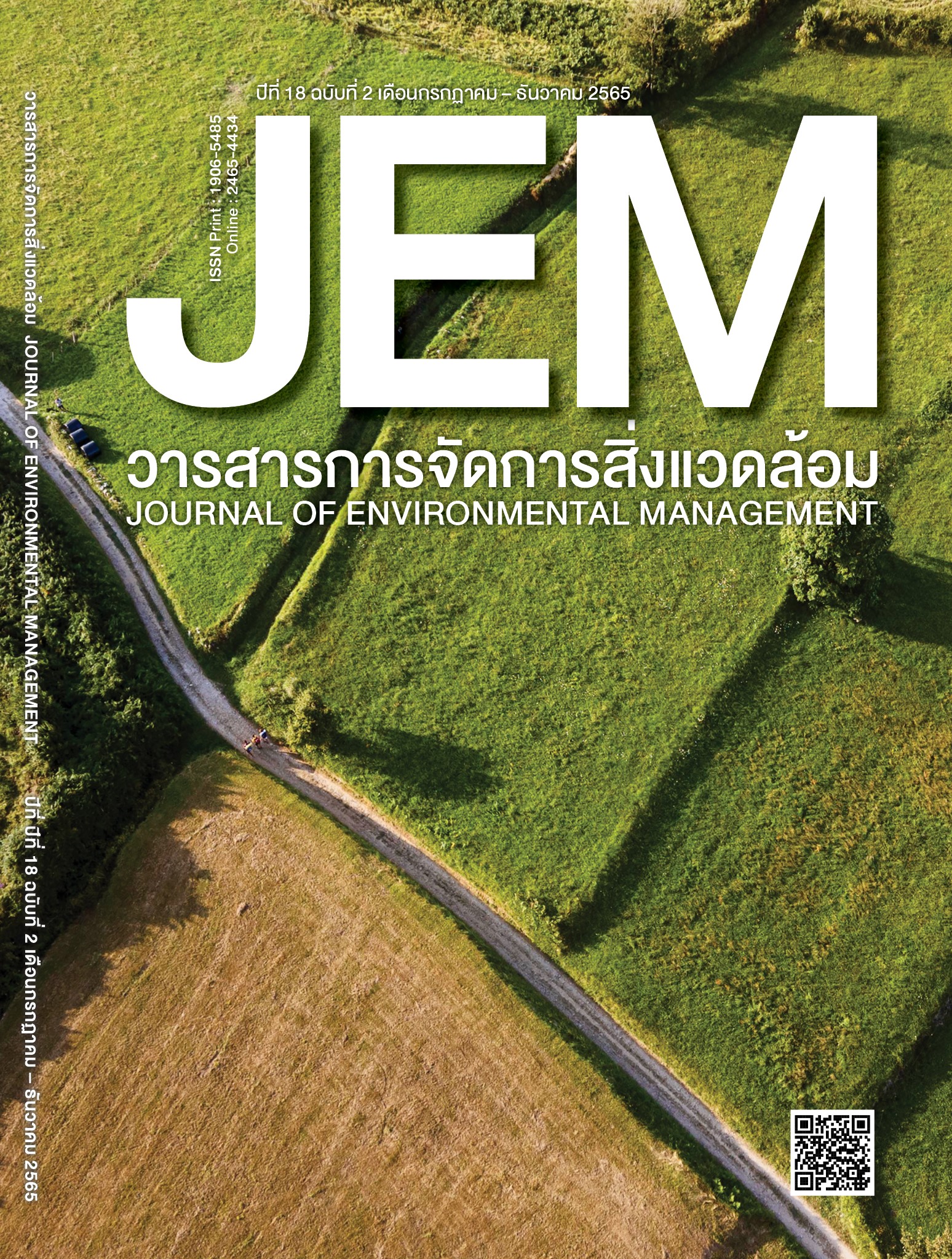การวิเคราะห์ปัจจัยขับเคลื่อนการเปลี่ยนแปลงการใช้ประโยชน์ที่ดินในพื้นที่ลุ่มน้ำลำเสียวน้อย
DOI:
https://doi.org/10.14456/jem.2022.11คำสำคัญ:
ปัจจัยขับเคลื่อน, การเปลี่ยนแปลงการใช้ที่ดิน, กรอบแนวคิดDPSIR, ลุ่มน้ำลำเสียวน้อยบทคัดย่อ
การศึกษาครั้งนี้มีวัตถุประสงค์เพื่อวิเคราะห์ปัจจัยขับเคลื่อนการเปลี่ยนแปลงการใช้ประโยชน์ที่ดินในพื้นที่ลุ่มน้ำลำเสียวน้อย โดยมีการพิจารณาปัจจัยขับเคลื่อนทั้งเชิงปริมาณและคุณภาพร่วมกัน โดยใช้สมการถดถอยโลจิสติกส์ (Logistic Regression Analysis) วิเคราะห์ความสัมพันธ์ระหว่างปัจจัยทางกายภาพ 8 ปัจจัยที่มีผลเกี่ยวข้องในพื้นที่ และวิเคราะห์เชิงคุณภาพโดยใช้กระบวนการบูรณาการกรอบแนวคิด DPSIR กับการเปลี่ยนแปลงการใช้ประโยชน์ที่ดิน ผลการศึกษาพบว่า ลุ่มน้ำลำเสียวน้อยมีการเปลี่ยนแปลงการใช้ประโยชน์ที่ดิน โดยพื้นที่ปลูกข้าว และมันสำปะหลังซึ่งถือเป็นพืชเศรษฐกิจที่สำคัญในพื้นที่ มีอัตราการลดลงจากพื้นที่เดิมในช่วงปี พ.ศ.2543 - 2553 คิดเป็นร้อยละ 2.89 และ 39.69 ตามลำดับ ในช่วงปี พ.ศ. 2553 – 2563 มีอัตราการลดลงของพื้นที่ป่า ในขณะที่พื้นที่มันสำปะหลัง ยูคาลิปตัส และยางพารา มีอัตราการเพิ่มขึ้นจากพื้นที่เดิมเป็นจำนวนมาก ทั้งนี้ปัจจัยทางกายภาพที่มีอิทธิพลกับประเภทการใช้ที่ดินมากที่สุด คือ การกระจายของคราบเกลือ จากการวิเคราะห์เชิงคุณภาพ พบว่า ปัจจัยขับเคลื่อนที่สำคัญต่อการเปลี่ยนแปลงการใช้ที่ดิน คือ ราคาผลผลิตทางการเกษตร และนโยบายการส่งเสริมของภาครัฐ ข้อมูลจากการศึกษาสามารถนำไปใช้ประโยชน์ในการคาดการณ์แนวโน้มการใช้ประโยชน์ที่ดินในอนาคต เพื่อวางแผนการใช้ที่ดินอย่างเหมาะสมและเพื่อการจัดการพื้นที่ให้เกิดการพัฒนาอย่างยั่งยืน
เอกสารอ้างอิง
Amir, A., & Mohammad H. G. (2019). Prediction of spatial land use changes based on LCM in a GIS environment for Desert Wetlands – A case study: Meighan Wetland, Iran. international soil and water conservation research, 7(1), 64-70.
Athiyaphan Sribunkhum, Karika Kunta, and Sunsanee Arunyawat. (2021). Factors Affecting the Land use Change in Lam Dom Yai Subwatershed. Burapha Science Journal, 26(3), 1777-1795.
Land Development Department. (2020). Land use map. Agriculture and cooperatives ministry. Bangkok.
Muhammad, H. S., and Han, S. L. (2019). Prediction of Land Use and Land Cover Changes for North Sumatra, Indonesia, Using an Artificial-Neural-Network-Based Cellular Automaton. Sustainability, 11(11), 3024.
National Water Resources Office. (2021). 22 watersheds in Thailand and the river basin decree B.E. 2021. (Academic Report in Thai).
Natthawat Tohngam and Chutarat Chompunth. (2015). Factors Affecting the Wetland Environment in a Ramsar Site: A Case Study of Don Hoi Lord, Samutsongkram. Rajabhat Rambhai Barni Research Journal, 9(2), 20-29.
Ongsomwang, S., & Iamchuen, N. (2014). Land use prediction using CLUE-S model a case study of Phayao lake, Phayao province. Journal of Remote Sensing and GIS Association of Thailand, 15(1), 26-31.
Ornetsmüller, C., Verburg, P., & Heinimann, A. (2016). Scenarios of land system change in the Lao PDR: Transitions in response to alternative demands on goods and services provided by the land. Applied Geography, 75(3), 1-11.
Pisvaran Kornpipat. (2019). Ecotourism Sustainability Analysis Framework. Environmental Journal, 23(1).
Reginal office4 of Land Development Department. (2015). Development and prevention of spreading on salt effected area in the Upper Lam Siew Noi basin.
Soil survey and classification division, Land Development Department. (2001). Major characteristics and potential of soil in Thailand. Agriculture and cooperatives ministry. Bangkok.
Thoeisiri, C. (2017). The extension of urbanized area and its effects on vulnerable area in surat thani province. Thammasat University.
Van, V. J., & Malek, Z. (2015). The Clumondo land use change model manual and exercises. University Amsterdam.
Wichit Lorgerachunkul & Jirawal Jitavet. (2012). The Development of Index and Sustainable Development Goals: SDGs in Regionals Thailand. Journal of NIDA Economic Review, 6(1), 135 – 163.



